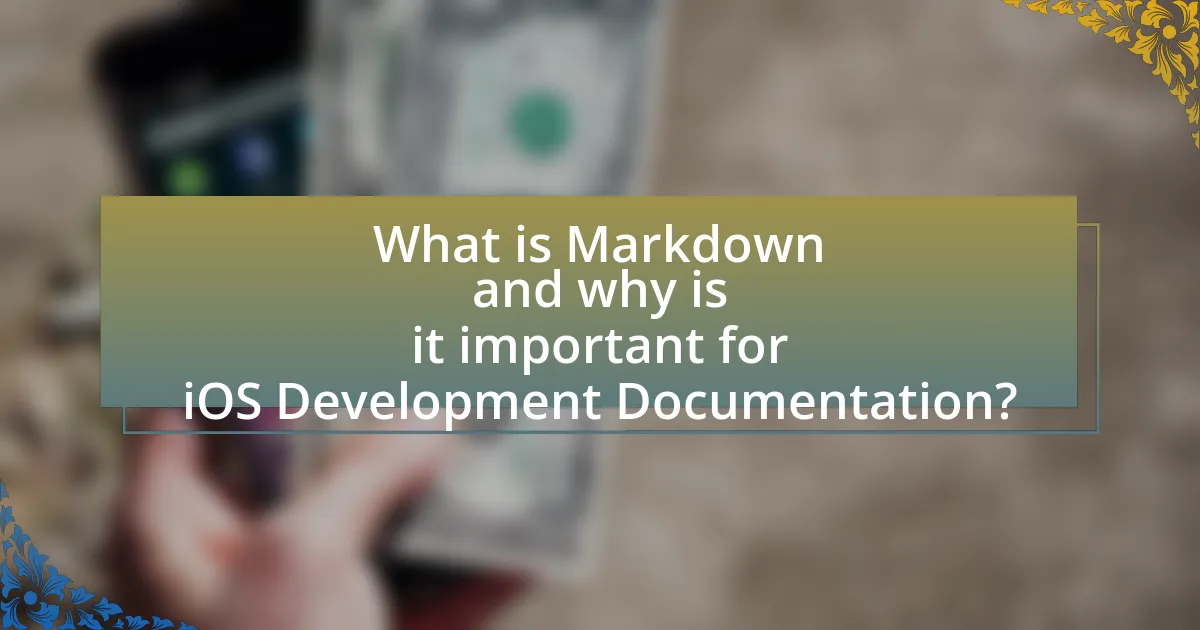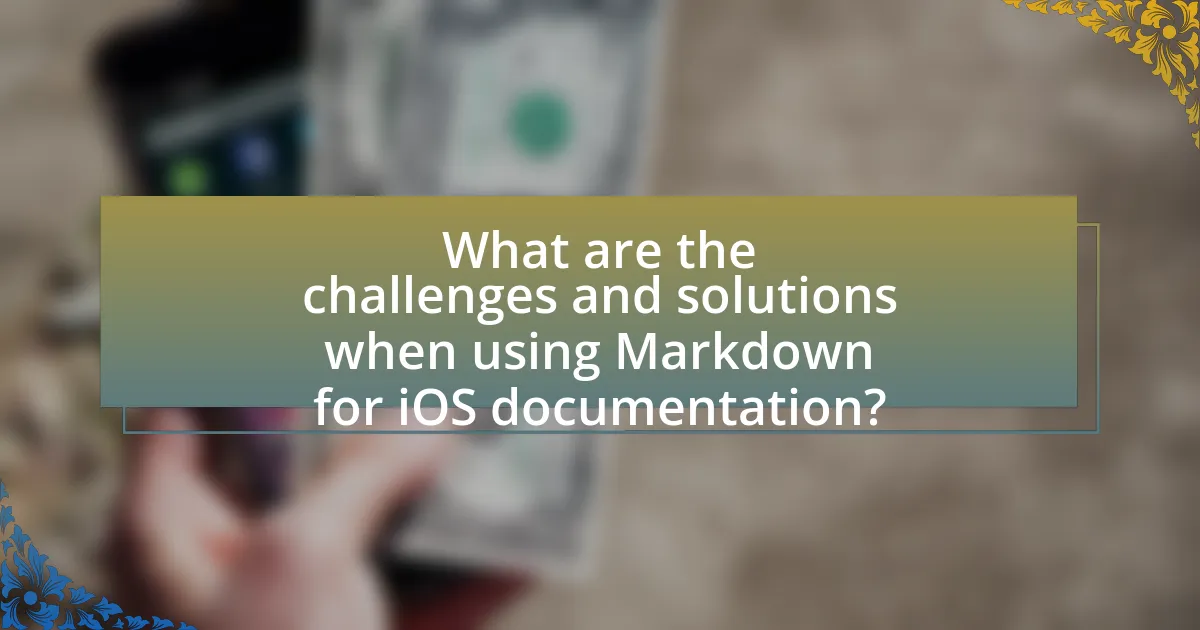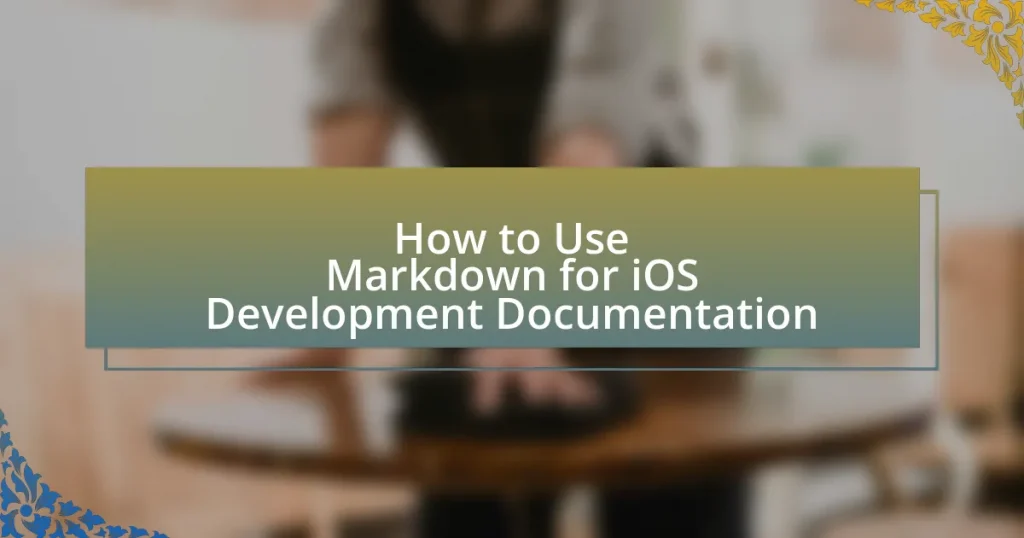Markdown is a lightweight markup language that plays a crucial role in iOS development documentation by enabling easy formatting, readability, and collaboration among developers. This article explores how Markdown enhances documentation through its simplicity, compatibility with various tools, and support for version control systems like Git. Key features such as structured formatting, the ability to create README files, user guides, and API documentation are discussed, along with best practices for organizing content and maintaining documentation. Additionally, the article addresses common challenges developers face when using Markdown and offers solutions to ensure effective implementation in iOS projects.

What is Markdown and why is it important for iOS Development Documentation?
Markdown is a lightweight markup language that allows developers to format text using plain text syntax. It is important for iOS development documentation because it enables easy readability and editing of documentation files, which can be rendered into HTML or other formats without losing structure. The simplicity of Markdown facilitates collaboration among developers, as it can be easily integrated into version control systems like Git, allowing for efficient tracking of changes and contributions. Additionally, many documentation tools and platforms, such as GitHub and Bitbucket, support Markdown, making it a widely accepted standard for creating clear and concise documentation in the iOS development community.
How does Markdown enhance documentation for iOS developers?
Markdown enhances documentation for iOS developers by providing a simple and efficient way to format text, making it easier to create and maintain documentation. Its lightweight syntax allows developers to focus on content rather than formatting, which streamlines the documentation process. Additionally, Markdown files are easily readable in plain text, facilitating collaboration and version control, as they can be tracked and edited using standard tools like Git. This efficiency is supported by the fact that many documentation generators, such as Jazzy and SwiftDoc, natively support Markdown, allowing for seamless integration into the iOS development workflow.
What are the key features of Markdown that benefit iOS documentation?
Markdown’s key features that benefit iOS documentation include simplicity, readability, and compatibility. The simplicity of Markdown allows developers to write documentation quickly without complex formatting, making it accessible for both technical and non-technical users. Readability is enhanced as Markdown files are plain text, which means they can be easily read and edited in any text editor, facilitating collaboration among team members. Compatibility is crucial, as Markdown can be converted to various formats such as HTML and PDF, ensuring that documentation can be shared and viewed across different platforms and devices. These features collectively streamline the documentation process in iOS development, promoting efficiency and clarity.
How does Markdown compare to other documentation formats?
Markdown is simpler and more user-friendly than many other documentation formats, such as HTML or LaTeX. Its plain text syntax allows for easy writing and editing, making it accessible for developers and non-developers alike. Unlike HTML, which requires knowledge of tags and attributes, Markdown uses straightforward symbols for formatting, such as asterisks for bold or italics, which reduces the learning curve. Additionally, Markdown files are lightweight and can be easily converted to various formats like PDF or HTML, enhancing their versatility. This ease of use and flexibility makes Markdown a preferred choice for many in software development and documentation, as evidenced by its widespread adoption in platforms like GitHub and Stack Overflow.
What are the common use cases of Markdown in iOS development?
Markdown is commonly used in iOS development for documentation, README files, and project wikis. In documentation, Markdown allows developers to create clear and structured guides that are easy to read and maintain. README files benefit from Markdown’s simplicity, enabling developers to provide essential information about the project, installation instructions, and usage examples in a visually appealing format. Additionally, project wikis utilize Markdown to facilitate collaborative documentation, allowing team members to contribute and edit content seamlessly. These use cases highlight Markdown’s effectiveness in enhancing communication and organization within iOS development projects.
How can Markdown be used for README files in iOS projects?
Markdown can be used for README files in iOS projects by providing a simple syntax for formatting text, which enhances readability and organization. This lightweight markup language allows developers to create structured documentation with headings, lists, links, images, and code snippets, making it easier for users to understand the project. For instance, using Markdown, developers can include installation instructions, usage examples, and contribution guidelines in a clear and concise manner. The popularity of Markdown in software development is evidenced by its widespread adoption in platforms like GitHub, where README files are automatically rendered, allowing for a visually appealing presentation of project information.
What role does Markdown play in creating user guides and API documentation?
Markdown serves as a lightweight markup language that simplifies the creation of user guides and API documentation by allowing authors to format text easily without complex syntax. Its role is significant because it enables clear structuring of content through headers, lists, and links, which enhances readability and organization. Additionally, Markdown files are easily convertible to various formats, such as HTML and PDF, making them versatile for different documentation needs. The simplicity of Markdown encourages collaboration among developers, as it can be easily edited in version control systems like Git, facilitating updates and maintenance of documentation.

How can iOS developers effectively implement Markdown in their documentation?
iOS developers can effectively implement Markdown in their documentation by utilizing Markdown syntax to create clear and structured text that enhances readability. This involves using headers, lists, code blocks, and links to organize information logically, making it easier for users to navigate and understand the content. For instance, using # for headers allows developers to create a hierarchy of information, while * or - can be used for bullet points, which helps in summarizing key points succinctly. Additionally, integrating Markdown with tools like Xcode or third-party documentation generators, such as Jazzy, can automate the conversion of Markdown files into formatted documentation, ensuring consistency and saving time. This approach is validated by the widespread adoption of Markdown in various programming communities, highlighting its effectiveness in improving documentation quality and user engagement.
What tools and editors are recommended for writing Markdown?
Recommended tools and editors for writing Markdown include Visual Studio Code, Typora, and Obsidian. Visual Studio Code is a versatile code editor that supports Markdown with extensions for previewing and formatting. Typora offers a seamless live preview feature, making it user-friendly for writing. Obsidian is designed for note-taking and knowledge management, providing a robust Markdown editing experience. These tools are widely used in the developer community, ensuring compatibility and support for Markdown syntax.
How do different Markdown editors support iOS development documentation?
Different Markdown editors support iOS development documentation by providing features that enhance readability, collaboration, and integration with development tools. For instance, editors like Typora and Obsidian offer live preview capabilities, allowing developers to see formatted text in real-time, which is crucial for maintaining clarity in documentation. Additionally, editors such as Visual Studio Code and Atom support Markdown extensions that facilitate syntax highlighting and code snippets, making it easier to document code effectively. Furthermore, many Markdown editors integrate with version control systems like Git, enabling seamless collaboration among team members and ensuring that documentation remains up-to-date with code changes. These features collectively enhance the documentation process for iOS development, making it more efficient and user-friendly.
What are the advantages of using integrated development environments (IDEs) for Markdown?
Integrated development environments (IDEs) offer several advantages for Markdown, including enhanced editing features, real-time preview capabilities, and integrated version control. These features streamline the writing process, allowing developers to focus on content creation without the distraction of formatting issues. For instance, IDEs often provide syntax highlighting and auto-completion, which improve readability and reduce errors. Additionally, the real-time preview allows users to see how their Markdown will render, facilitating immediate adjustments. Furthermore, built-in version control systems enable easy tracking of changes, which is essential for collaborative projects in iOS development documentation.
How can developers structure their Markdown documents for clarity?
Developers can structure their Markdown documents for clarity by using a consistent hierarchy of headings, bullet points for lists, and clear formatting for code snippets. A well-defined heading structure, such as using H1 for the main title, H2 for sections, and H3 for subsections, helps readers navigate the document easily. Bullet points and numbered lists enhance readability by breaking down complex information into digestible parts. Additionally, using code blocks for programming examples ensures that code is easily distinguishable from regular text, which aids in comprehension. These practices align with Markdown’s capabilities and improve the overall user experience in documentation.
What are the best practices for organizing sections and headings in Markdown?
The best practices for organizing sections and headings in Markdown include using a clear hierarchy, consistent formatting, and descriptive titles. A clear hierarchy involves using headings (H1, H2, H3, etc.) to indicate the structure of the document, where H1 is reserved for the main title, H2 for major sections, and H3 for subsections. Consistent formatting ensures that similar types of content are styled the same way throughout the document, which aids readability. Descriptive titles provide context and help users quickly understand the content of each section. These practices enhance navigation and comprehension, making documentation more effective for iOS development.
How can developers use lists, tables, and images effectively in Markdown?
Developers can use lists, tables, and images effectively in Markdown by leveraging their structural capabilities to enhance readability and organization of documentation. Lists allow for clear itemization of features or steps, making information easily digestible; for example, using bullet points for features or numbered lists for instructions. Tables can present data in a structured format, facilitating comparison and clarity; for instance, a table can summarize API endpoints with their methods and descriptions. Images can be embedded to provide visual context or examples, which aids in understanding complex concepts; for example, including screenshots of the app interface can illustrate functionality. These elements, when used appropriately, improve the overall user experience of the documentation, making it more accessible and informative.

What are the challenges and solutions when using Markdown for iOS documentation?
Using Markdown for iOS documentation presents challenges such as limited formatting options and compatibility issues with various tools. Limited formatting can hinder the presentation of complex information, while compatibility issues may arise when integrating Markdown with iOS development environments or documentation generators.
Solutions include utilizing Markdown extensions that enhance formatting capabilities, such as adding tables or footnotes, and ensuring that the chosen documentation tools support Markdown natively. Additionally, employing a consistent workflow that includes testing the Markdown output in the intended environment can mitigate compatibility problems. These strategies help streamline the documentation process and improve the overall quality of iOS documentation.
What common issues do developers face when using Markdown?
Developers commonly face issues with Markdown related to inconsistent rendering across different platforms, limited support for advanced formatting, and difficulties in integrating Markdown with other tools. Inconsistent rendering occurs because Markdown interpreters can vary, leading to discrepancies in how text appears in different environments. Limited support for advanced formatting, such as tables or footnotes, can hinder the ability to create complex documents. Additionally, integrating Markdown with version control systems or documentation generators may present challenges, as not all tools handle Markdown uniformly. These issues can complicate the documentation process and affect collaboration among developers.
How can formatting inconsistencies be resolved in Markdown documents?
Formatting inconsistencies in Markdown documents can be resolved by standardizing the use of syntax and employing a Markdown linter. Standardization involves consistently applying heading levels, list formats, and spacing throughout the document. A Markdown linter, such as Markdownlint, checks for adherence to specified formatting rules and highlights inconsistencies, allowing for easy correction. This approach ensures that the document maintains a uniform appearance and improves readability, which is essential for effective iOS development documentation.
What strategies can be employed to ensure compatibility across platforms?
To ensure compatibility across platforms, developers should adopt responsive design principles, utilize cross-platform frameworks, and adhere to standardized coding practices. Responsive design allows applications to adapt to various screen sizes and orientations, enhancing user experience on different devices. Cross-platform frameworks, such as React Native or Flutter, enable developers to write code once and deploy it across multiple platforms, reducing inconsistencies. Standardized coding practices, including the use of HTML5 and CSS3, ensure that applications function uniformly across different browsers and operating systems. These strategies collectively minimize compatibility issues and streamline the development process.
What are the best practices for maintaining Markdown documentation?
The best practices for maintaining Markdown documentation include organizing content with clear headings, using consistent formatting, and regularly updating information to ensure accuracy. Clear headings help users navigate the documentation easily, while consistent formatting enhances readability and comprehension. Regular updates are crucial as they keep the documentation relevant and reflect any changes in the project or technology. Additionally, incorporating version control systems, such as Git, allows for tracking changes and collaborating effectively, which is essential in software development environments.
How often should Markdown documentation be updated in iOS projects?
Markdown documentation in iOS projects should be updated regularly, ideally with each significant code change or feature addition. This practice ensures that the documentation remains accurate and reflects the current state of the project, facilitating better collaboration and understanding among team members. Regular updates, such as during sprint reviews or after major milestones, help maintain the relevance and usability of the documentation, which is crucial for onboarding new developers and ensuring project continuity.
What tools can assist in version control for Markdown documentation?
Git is a primary tool that assists in version control for Markdown documentation. It allows users to track changes, collaborate with others, and manage different versions of documents efficiently. Git’s distributed nature enables multiple users to work on the same project simultaneously without conflicts, making it ideal for collaborative environments. Additionally, platforms like GitHub and GitLab provide user-friendly interfaces for managing Git repositories, facilitating easier access to Markdown files and their version histories. These tools are widely adopted in software development and documentation processes, ensuring that changes are logged and can be reverted if necessary.
What tips can enhance the effectiveness of Markdown in iOS development documentation?
To enhance the effectiveness of Markdown in iOS development documentation, utilize clear headings, bullet points, and code blocks for better readability. Clear headings structure the content, making it easier for developers to navigate through sections. Bullet points help in summarizing key information succinctly, while code blocks allow for the presentation of code snippets in a visually distinct manner, improving comprehension. According to a study by Nielsen Norman Group, well-structured documentation significantly increases user satisfaction and reduces the time needed to find information, validating the importance of these formatting techniques in Markdown.











